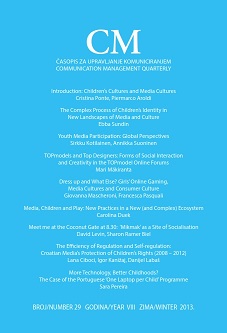TOPmodels and Top Designers: Forms of Social Interaction and Creativity in the TOPmodel Online Forums
TOPmodels and Top Designers: Forms of Social Interaction and Creativity in the TOPmodel Online Forums
Author(s): Mari MäkirantaSubject(s): Gender Studies, Media studies, Social Informatics, Marketing / Advertising
Published by: Fakultet političkih nauka Univerziteta u Beogradu
Keywords: girlhood; Internet; online community; self-expression; social interaction; gender; creativity;
Summary/Abstract: The TOPmodel brand contains products for girls aged 7–15, such as notebooks, colouring books, accessories, and pens and pencils. The brand has also a website and an active online community, whose main purpose is to advertise TOPmodel products and provide information on how to learn about fashion, beauty, and consumerism. In this article, I explore the English version of the TOPmodel website (http://en.topmodel. biz/index_en.html), and ask what kind of social interaction the TOPmodel online forums enable for children, especially girls. What kind of creativity can be found from the contents and girls’ actions within Web 2.0, and in what terms? Discourses of children’s media use have varied from worry about their actions to the many possibilities of online participation. On the one hand, children are seen as vulnerable to the commercial contents of the Internet, which is filled with different brands and effective marketing aimed at young people. On the other hand, there has been an increasing interest in children creating their own cultures and online content. This article focuses mainly on the latter perspective: I study the possibilities of children’s self-expression, creativity, and ability to share and discuss different topics with each other. I define girls’ Internet use as a sense of formability and belonging, which explains how girls participate in constructing the TOPmodel brand, create online content and engage intensely in virtual community. A sense of formability and belonging also refers to girls’ possibilities to reformulate the predefined online topics, create alternative designs and form social relationships within online forums. My analysis is based on empirical data from six months of ethnographic participatory observations of online activity.
Journal: CM Komunikacija i mediji
- Issue Year: 8/2013
- Issue No: 29
- Page Range: 61-78
- Page Count: 18
- Language: English

